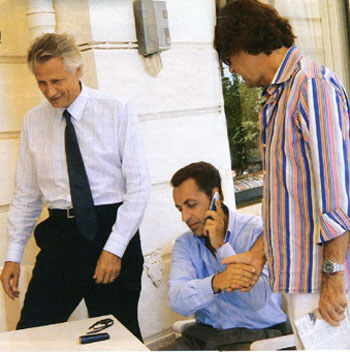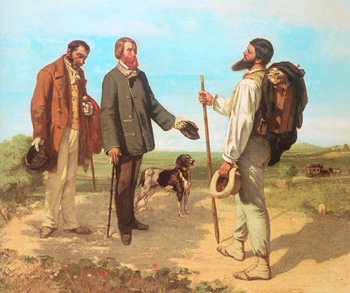 |
Manners, Customs, Clothing
The Importance of the Greeting
Prof. Plinio Correa de Oliveira
I have noticed that it is not a habit among youth today to greet their acquaintances when they meet either in the street or an enclosed place. I would like to point out that, according to Catholic customs, the greeting is a duty of justice toward our neighbor and, at times, also a duty of charity.
Encountering a person one knows, it is normal to be pleased and display this reaction in a suitable way. When one of us meets a counter-revolutionary who has given his life to restore Christian Civilization, it is natural to express one’s joy, attention and consideration in a proportionate way by means of the greeting.
The salutation is so important that the Angelus is called the perfect salutation. The Gospel tells us that the Archangel Gabriel approached Our Lady, greeted her, and then transmitted the good news he was sent to deliver. Some artists used to present St. Gabriel kneeling before Our Lady as he greeted her.
The Catholic liturgy is also rich in salutations. Consider, for instance, the many times incense is used to honor God, as well as for the Bishop, priest, and even the people. These salutations are linked to the sacred character of the worship of God and the mission of its ministers. The people who are worshiping God also merit respect. So, these salutations are linked to the virtue of religion, which pertains to the glory and worship of God. An analogous thing can be said about the greetings we make in society.
Therefore, we should take care to salute others appropriately; this applies particularly to those who are counter-revolutionaries. We should also cultivate the art of greeting others as a measure of counter-attack against the revolutionaries who are destroying it.

The revolutionary way: Sarkozy shakes the hand of a visitor without rising, looking at him, or interrupting his call |
In History, you can see that in eras with a strong Catholic influence, salutations were long, beautiful, and distinguished. Each greeting was a true example of culture. A person who would greet another would make a beautiful gesture, a respectful inclination of the head, an elegant motion of the body, followed by kind words. Those words were habitually quite elevated expressing noble sentiments and following some general formulas.
To the measure that the Revolution progressed, salutations lost their beauty and elegance. With the French Revolution, they suffered a strong blow. Prior to it, it was customary for the man to make a reverence, or bow, to the woman, who responded in turn with a curtsy. Thenceforward it was reduced to the man simply taking off his hat, and the woman making a small inclination of head. Then the hats disappeared, and now the feminine spirit is also vanishing with the rise of feminism.
A person’s sense of self-respect is also fading as well as respect for others. This general lack of respect makes a distinguished greeting appear as an almost empty ceremony. Salutations are becoming increasingly simplified: a minuscule gesture, a lifting of the eyebrows, a small smile. We are on the eve of the death of the art of the greeting, which was one of the flowers of Christian Civilization.
In response to this decline, we should take special care in the distinction and propriety of our greetings.
So, when we meet an acquaintance in the street, we should greet him or her. If two men are crossing paths and are not in a hurry, it is appropriate to stop briefly, greet one another, shake hands, and say a few amiable words. If both are walking quickly, a cordial gesture followed by a friendly “Hello, Mr. X, it is nice to see you,” is indispensable.

The Catholic way: Two men meet a pilgrim on the road, stop their walk and offer a greeting |
If a man and woman meet, the man should stop, even if he is rushing. He should put aside his hurry, shake hands with Miss Y or Mrs. Z, say a few amiable words, and then add: “I am sorry I can’t visit with you longer, but I am late for a meeting. It would be unforgivable, however, for me not to have the pleasure of greeting you even briefly. I hope to prolong this pleasure on another occasion in the near future.” We should always greet those who are close to us in our fight or in our circle of relations.
In a building or enclosed ambience, persons of equal social status or importance should greet each other with a cordial and formal, “How are you doing, Mr. X?” If they are close friends, the Mr. may be omitted, “How have you been, John?” A handshake is highly recommended, followed by a few amiable words. If there is a difference in status or age between the persons who meet, the younger or lesser in importance should take the initiative of seeking out the other to greet him, and show a special respect in the exchange of words.
If such persons should meet more than once, at work or a social event, it would be enough to give a simple wave of the hand and “See you soon” upon leaving for a meal or meeting. When the work day or social event comes to an end, a cordial “Good evening” would be indispensable.
Some one could object: I don’t know why you are wasting time talking about such a trifling matter.
I respond: This is not a trifling matter. The person with a Catholic spirit wants everything to be in accordance with Catholic customs. The art of greeting was a fruit of Christian Civilization that should be maintained as much as possible. Insomuch as it is being done away with by the Revolution, it should be restored. Matters of courtesy and good treatment are serious matters that affect the honor, reputation and good relationships of men. Therefore, there is nothing trifling about them.

Posted August 17, 2006

Related Topics of Interest
 Dressing Well: Vanity or Virtue? Dressing Well: Vanity or Virtue?
 St. Isidore of Seville on the Importance of Good Manner St. Isidore of Seville on the Importance of Good Manner
 Four Ways to Discern a Man's Soul by His Appearance Four Ways to Discern a Man's Soul by His Appearance
 A Man’s Bearing Reflects His Education and Virtue A Man’s Bearing Reflects His Education and Virtue
 Manners Make Life Easier Manners Make Life Easier
 Courtesy in the Catholic Home Courtesy in the Catholic Home

Related Works of Interest
|
|
Manners |
Cultural | Home |
Books | CDs |
Search | Contact Us |
Donate

© 2002- Tradition in Action, Inc. All Rights Reserved
|
 |

|